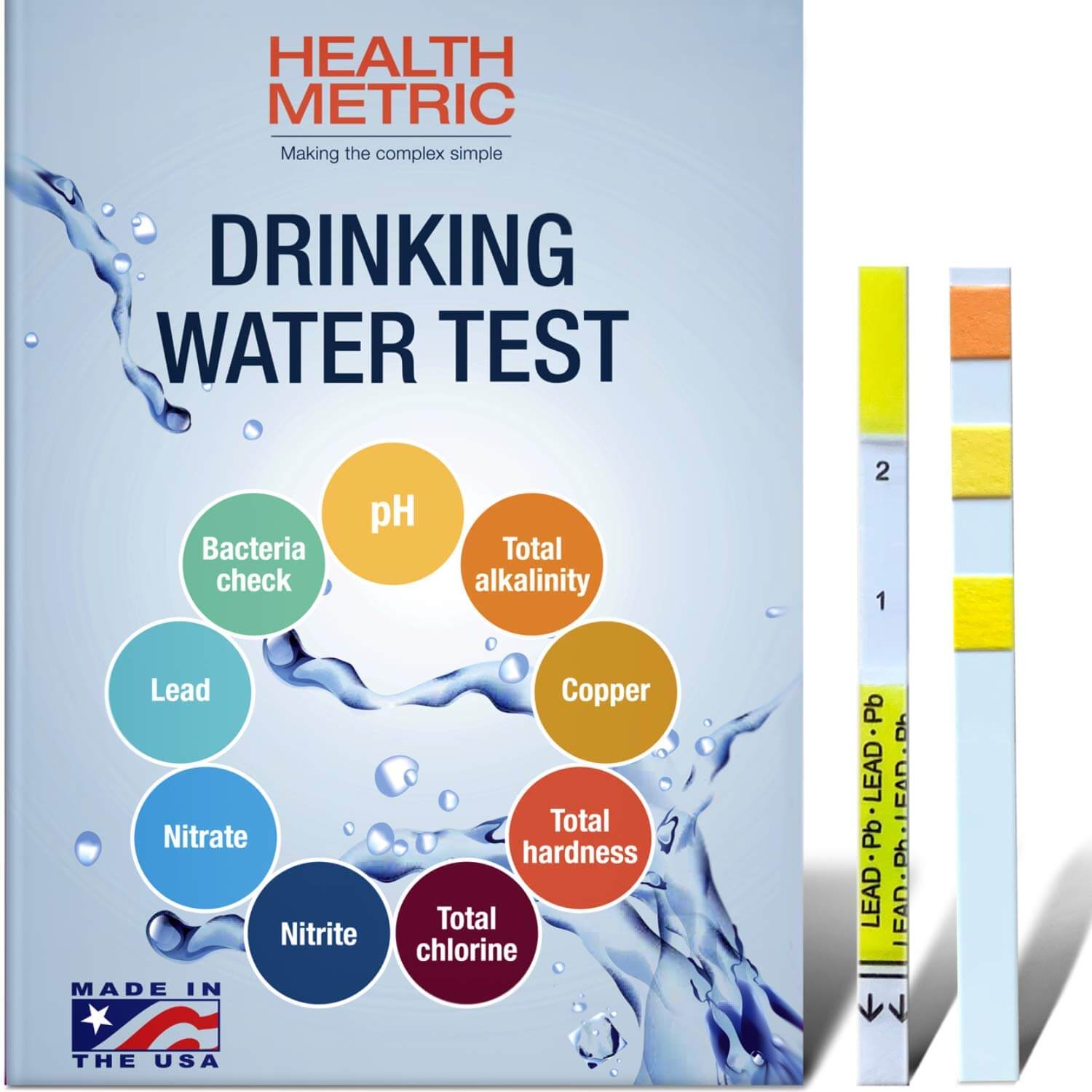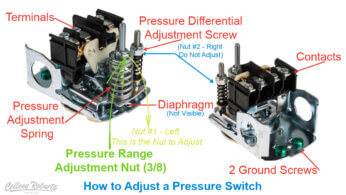
Information Guide About Lead in Water
Drinking lead in water is hazardous and can cause irreversible health effects, especially in children. Drinking water is one potential lead source in homes and facilities in the USA. Our 2023 Test Lead in Water Guide will help to determine if you have a lead service line, lead pipes, fittings, or other plumbing materials bringing water into your home.
Many people question lead in drinking water in the USA. Lead occurs naturally and as a result of human activities, but in nature, lead is typically not found free in its pure form; lead is contained in ores with other metals — the most abundant one in the Earth’s crust is galena (PbS). Natural lead formations occur by the radioactive decay of uranium and thorium through radon (222Rn).
Four stable isotopes are known: 204Pb, 206Pb, 207Pb, and 208Pb, the first three of which are used to estimate the age of rocks. Lead compounds exist mainly in +2 or +4 oxidation states, with the former being more common.
Lead is a Heavy Metal – Can Be Found in Many Household Items
Our Test for Lead in Water 2023 Guide provides tips to reduce lead exposure, information on testing your drinking water, and resources to learn more about Lead in Water in the USA.
Lead is a heavy metal found in many household items, including paint, plumbing pipes, and water faucets. When they deteriorate, these items can release lead into the air, water, or soil. Exposure to lead can cause various health problems, from stomach upsets and constipation to anemia and learning difficulties. Children are particularly vulnerable to the effects of lead poisoning, as their bodies are still developing. Even low levels of lead exposure can cause behavior problems, lower IQ scores, and difficulty paying attention.
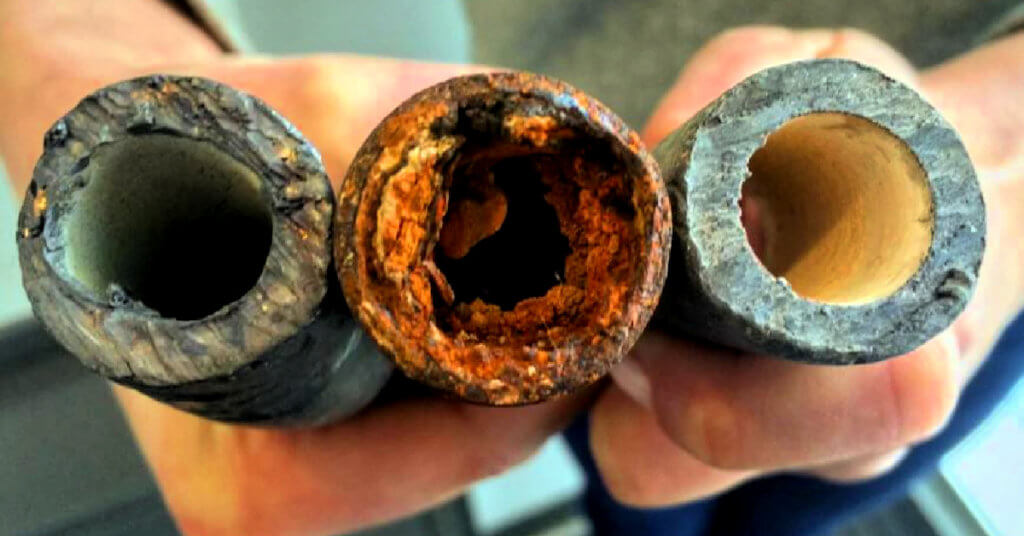
First Steps: Lead in Your Drinking Water
If you’re concerned about lead in your water, the first step is to check for a lead service line and test your water. This guide provides clear, step-by-step instructions on how to identify a lead service line and tips to reduce your exposure to lead if you do have one. It also includes information on testing your water for lead and resources for learning more about this critical issue.
A Quick and Easy Way to Test for Lead in Drinking Water
Lead Drinking Water Test Kit for Municipal Tap or Well Water – Simple Testing Strips for Lead Copper Bacteria, Nitrates, Chlorine and More. If you just want a simple water testing solution these kits realiable and easy to use!
Following these steps can help protect yourself and your family from the dangers of lead exposure.
It’s easy to test for lead in water with a home test kit or by sending your water sample to a certified laboratory.
What is Lead?
Lead is a naturally occurring metal with a bluish-silver hue that can enter tap water from natural deposits or industrial activity. Lead in homes can also come from paint, dust, soil, air, and food.
How Does Lead Enter Our Drinking Water?
But mostly lead enters drinking water because of the corrosion of the water pipes delivering water to homes or from plumbing in your home. Drinking water is a potential source of lead in homes.
Lead in Drinking Water and Old Plumbing
So, if you have old plumbing in your house (or even just bought the property where there’s a possibility of lead), remember that lead is toxic to humans, and no amount of it is considered safe. Lead accumulation affects many of our body’s organs over time, making it critical to understand what health problems could arise from drinking water contaminated with lead.
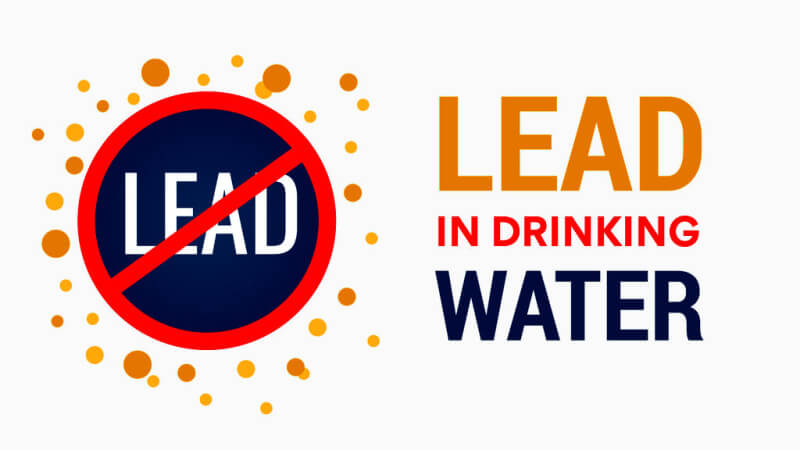
What are Safe Levels of Lead in Water?
In 1991, EPA published a regulation to control lead and copper in drinking water. This regulation is known as the Lead and Copper Rule, or the LCR. The EPA Lead and Copper Rule has been revised several times since 1991 to strengthen the LCR.
EPA and the Centers for Disease Control and Prevention (CDC) agree that a child’s blood has no known safe lead level. Reducing these exposures can improve outcomes. Lead is harmful to health, especially for children.
Under the authority of the Safe Drinking Water Act, EPA set the action level for lead in drinking water at 15 ppb (0.015 mg/L). This means utilities must ensure that water from the customer’s tap does not exceed this level in at least 90% of the homes sampled (90th percentile value).
Consuming Lead in Drinking Water May Lead to Serious Illness
Drinking lead in drinking water is a dangerous metal that can have severe consequences for your health. It may lead to an increased risk of cancer, hypertension, reproductive problems, and neurological disorders, as well as issues with the kidneys, immune system, or bones – these are just some examples of how lead in drinking water can affect us. The EPA has set its public goal of zero lead this toxic substance because they know what an impact eliminating drinking water sources would make across America’s communities nationwide.
EPA – Goal of Zero Lead in Drinking Water in the USA
The EPA has declared that it wants to achieve a goal of zero lead in drinking water. They also enforce an upper limit for how much can be present: 15 parts per billion, meaning water utilities must test the water regularly for lead and take action if lead contamination is found.
Once 10% of tests show lead concentrations greater than 15 ppb, a water utility must improve. This is called an “action level” and means that there are high risks for public health if not adequately addressed.
Exposure to Lead May Seriously Harm a Child’s Health
We should be aware that children are especially vulnerable to even low levels of lead; low-level lead exposure can slow a child’s development, damage the brain and nervous system, and even lead to problems with learning, behavior, hearing, and speech development in children’s developing brains (Kolassa et al., 2009). Low lead levels over time could also damage the nervous system, affecting everything from movement to temperament!
If you have children, you might consider checking your school’s drinking water for lead. Since there are no federal regulations requiring schools to test drinking water for lead, schools remain vulnerable populations. Worse, lead in water has no smell, taste, or even color. This leaves millions of children potentially exposed to toxic levels of lead through their water faucets if not adequately maintained.

Test Your Well Water Anually – Local Water Testing Laboratories
Do you own a private water well? Total coliform is the most commonly used indicator of bacterial contamination. The presence of coliform bacteria is an “indicator” of a well’s possible contamination from human or animal wastes. Total coliform are a broad category of bacteria, most of which pose no threat to humans.
Some come from fecal matter; others naturally occur in soils, vegetation, insects, etc. The presence of coliform bacteria in well water can be a harbinger of worsening water quality. In some cases, more specific tests for fecal contamination, such as E.coli, may be used.
Why Would Our Home Drinking Water Contain Lead?
Several ways lead can enter your home drinking water. One of the most common is through “lead service lines.” Lead service lines are dangerous, and if you have such pipes, you should consider lead service line replacement.
Lead service lines connect a home to the main water line, and lead can leach from service lines into tap water. In homes served by lead service lines, it’s likely the most significant source of lead in drinking water.
Lead can also be found in other plumbing materials and faucets. Water with high acidity (low PH) or low mineral content (also known as aggressive water) can corrode pipes and faucets, causing lead to leach into your home drinking water, especially with the hot water lines.
You can do a few things if you’re concerned about lead in your drinking water. First, you can have your water tested by a certified laboratory. You can also install a water filter that is certified to remove lead. Finally, you can avoid using hot tap water for cooking or drinking since lead dissolves more easily in hot water. Taking these steps can help protect yourself and your family from lead exposure.
If your home is currently fed water by a lead service line, the best advice is to get a couple of estimates for the cost of lead service line replacement. Lead pipes are dangerous in homes and should be replaced and upgraded.
Corrosion Overview – How Lead Gets into Home Tap Water
Low PH. A low PH (less than 7) indicates that your water is acidic. Acid water can dissolve plumbing pipes from the inside and is a common cause of copper pipe corrosion.
Lead is known to enter the water when a chemical reaction occurs in plumbing pipes, fittings, and other materials that contain lead. This is reaction is known as corrosion – dissolving or the wearing-away of metal from the plumbing materials.
This reaction is more severe when the water has high acidity or low mineral content. Minerals help protect pipe fixtures from corrosion. Acidic water causes a chemical reaction that dissolves or wears away the metal pipes and fixtures.
How much lead enters the water is related to the following:
- Amount of lead in the plumbing materials
- Acidity or alkalinity of the water
- Types and amounts of minerals in the water
- Amount of lead that water is in contact with
- The temperature of the water
- Amount of wear in the pipes,
- How long has the water been in contact with the plumbing materials
- Whether or not the water is treated with chemicals to prevent corrosion
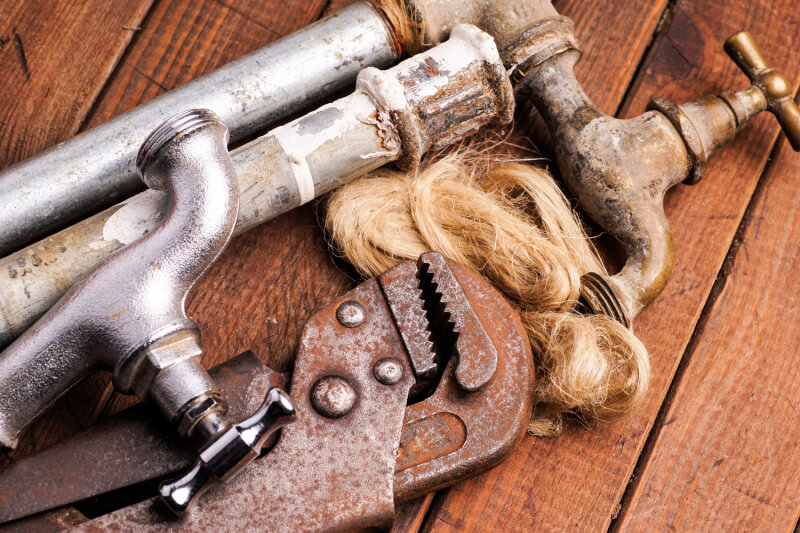
What do Lead Pipes Look Like?
First of all, to understand what’s going on, it’s essential to have your water tested for lead by an accredited water laboratory.
Lead service lines are an undetectable hazard to human health, allowing lead to leach into drinking water. When water comes in contact with lead pipes, a chemical reaction occurs in the pipes that contain lead. This reaction is known as corrosion; when that surface is a lead pipe, some lead dissolves into the water even when corrosion control treatment is used.
There is no known level of exposure to lead that is without harmful effects. Lead service lines and small-diameter plumbing pipes providing water in older homes can be compared to lead straws, causing an ongoing danger of lead exposure.
The most common sources of lead in drinking water are lead pipes, water faucets, and plumbing materials and fixtures. Exterior pipes transporting drinking water from the water source to the home may also contain lead. A home’s plumbing fixtures, solder, and pipe fittings made before 1986 might also contain lead.
It’s essential to know what the service line to your house or a house you may be purchasing is made from, it may not be made from lead, but it’s still good to know. Typical water service line materials may include lead, copper, galvanized steel, PVC, and other plastic materials.
Water service lines are just the small pipes that connect water mains. The larger ones generally run under or parallel to the street, stopping right at a homeowner’s property line. Lead service lines were still commonly installed until the mid-80s.
And where are all those lead service lines today? A lot of them are still in use. Finally, installing new lead service lines was banned entirely in 1988. But there has never been a national requirement to remove lead service lines already in place; it’s difficult to know for sure due to lack of data, but it’s estimated there may still be 10 million lead service lines in use providing water.
Is Your Home Utilizing a Lead Service Line?
To begin with, let’s review a few dates…
- What year was your house built?
- Your home is older; when was it connected to the local water utility or water well?
- Was your house renovated? Or was a new home built replacing an old house on a property previously serviced by the water supply? What year was that?
This information is often easily accessible. You can search tax records, real estate listings for the property, and maybe building permits that include the year the house was built or renovated.
The first water service will most often be connected to the year the original house was constructed on the property. If the home was initially serviced by a private water well, there might still be lead pipes. If your home was not constructed until after 1988, there is likely little to be concerned about regarding lead service lines. Also, you should know that not all homes built before 1988 have lead service lines. Not all communities used lead service lines; some used them extensively until the ban on the lines in 1988.
Your city might still have lead service lines from the water main to the curb. The best thing to do is call your city to see what records might be available to you and your neighbors.
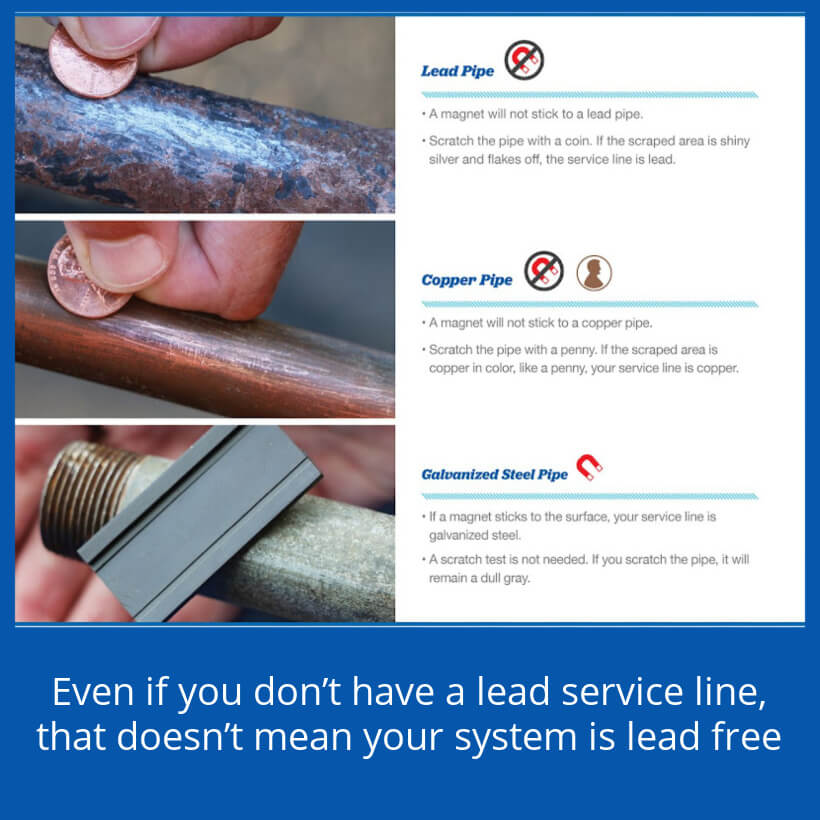
How to Check Your Water Service Line for Lead
The water service line from the city water main into your house is normally in the basement or crawlspace if you don’t have a basement. It will usually be located at the lowest point in the house.
If you can see that the service line is dark matte gray, that’s usually a good indicator that you may have a lead service line in your home.
You can also gently scratch the service line with a coin or a screwdriver. If it’s lead, the metal will be soft and leave a shiny silver scratch in the pipe.
Copper water pipes are usually bronze, bright, or dark orange made of tough material. Scratching a copper pipe with a coin will leave a faint bronze-colored mark.
Aside from lead or copper, other materials may have been used; you can also have a plastic or galvanized steel service line in your house. If it’s steel, a magnet will stick to it. If it’s lead or copper, a magnet will NOT stick to it to the pipe.
Important to note: Even if you don’t have a lead service line in the basement, that doesn’t mean your line is lead-free. It is possible there could’ve been a partial lead service line replacement, which means part of the line under your yard could still be lead, even if some of it is copper or steel.
Always remember- it’s essential to test your water for lead. If there is any question, certified water filtration for lead in drinking water may also be considered.
Where Does Your Drinking Water Come From?
Rent or Own a Home in a Housing Complex
Most people in the United States get their drinking water from public water systems. These systems are required to meet federal lead regulations, but lead can still enter drinking water when service pipes that connect homes and businesses to water mains are made of lead. If you rent or own in a housing complex, you can ask your landlord/property manager for information on your water supply and what is being done to reduce lead exposure.
The Environmental Protection Agency (EPA) recommends that landlords/property managers:
- Regularly test for lead levels in the drinking water.
- Provide tenants with information on lead in drinking water.
- Install and maintain lead service line replacements where necessary.
- Install and maintain plumbing fixtures that do not contain lead.
- Provide water filters for residents who request them.
By following these recommendations, landlords/property managers can help ensure their tenants have safe and clean drinking water.
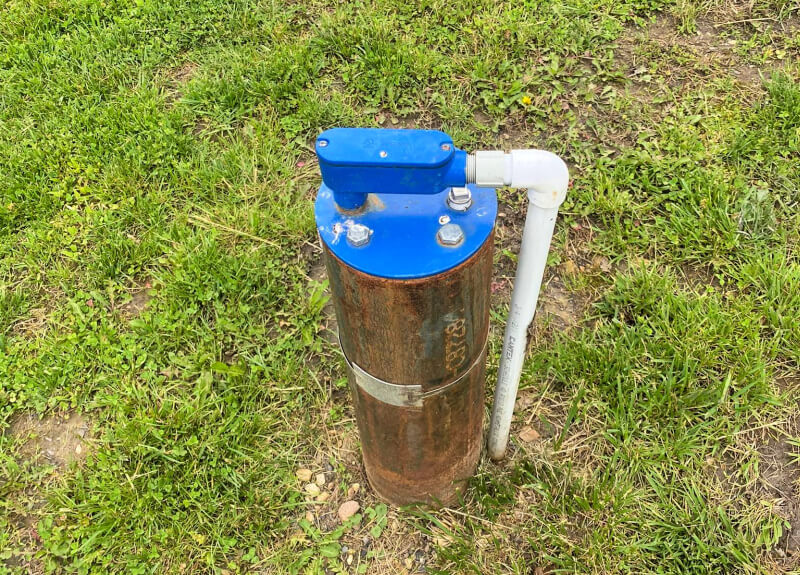
Private Water Wells and Lead in Drinking Water
Over 42 million people in the United States depend on private water wells for their drinking water source, and the EPA does not regulate private water well systems. Many states and towns in the United States do not require sampling of private wells after installation; it’s the sole responsibility of the water well owner to maintain the safety of the water serving their property from a private water well.
While lead in drinking water is not typically a problem in a water well, you could still have lead well pump installation materials, water pipes & fittings (exterior and interior), lead solder that joins pipes, or faucets that may contain lead, etc.
If you are a private water well owner, you must regularly test your water for many other parameters besides lead in drinking water. Water quality can be an issue if it is not tested or goes untested for an extended period. If you suspect that there may be lead in your drinking water or other possible contaminants, test your water immediately,
Municipal Water Supply and Lead in Drinking Water
The first step would be to contact your water supplier and ask: Does the water utility know the locations of lead service lines in our town and is one connecting my home to the water main?
More and more water utilities are urged to digitize their services to provide their customers with better information and communication. One of the most critical aspects of this is more cost-effectively predicting the locations of lead service lines.
What Do the Lead Copper Rule Revisions Mean, and How Does it Affect Your Household?
The new revised Lead and Copper Rule in the USA is designed to protect children and communities by minimizing exposure to lead and copper in drinking water. To meet the new standards, utilities, treatment plants, and schools must make significant changes. But what does that mean for your household?
For starters, if you have lead pipes or copper pipes with lead solder, you may be required to replace them. You may also be required to install a filter or take other steps to reduce the amount of lead and copper in your water. The good news is that many options are available, and you can work with your local water utility to find the best solution for your home.
In addition, it’s essential to be aware of the potential for lead and copper exposure in your home. If you live in an older home, you may want to have your water regularly tested for lead and copper. Reducing your children’s exposure to lead and copper is imperative. We can help protect our families from lead and copper exposure by working together.
How Can Water Utilities Locate Lead Service Lines More Cost Effectively?
This can be done by combining existing inventories, geographic information systems, and predictive modeling. By doing this, residents can be made aware of water quality issues more quickly. Additionally, introducing a more comprehensive range of communication options (e.g., text, email, in-app notifications) allows people to choose how to keep up-to-date. All in all, digitization is vital for water utilities in the modern age.
Your local water utility may contact you about updating your communication preferences. This is so that when lead water lines are replaced in your area, you can track which lines have been replaced and which ones still need to be replaced.
Additionally, updated customer data will ensure that pre- and post-replacement lead-in drinking water test kits, filter pitchers, etc., will be sent to the correct address. Accurate customer data is vital so everyone can be on the same page and lead water line replacements can go as smoothly as possible.
If you have any questions, don’t hesitate to contact your water utility company. They will be more than happy to help you out. Thanks for doing your part in ensuring a smooth process!
TEST LEAD IN WATER
Tap Score Water Test Kit provides all required materials to properly collect and submit a sample for certified laboratory testing. Reported results will include detailed, analysis of lead and copper by EPA method 200.8 (or equivalent).
How Do You Test For Lead in Drinking Water?
When testing for lead in water, you’ll need to take a water sample from your tap. This involves making some decisions about things like sampling location and sampling method. Ultimately, there are no wrong answers. It simply comes down to what information you are most interested in knowing.
Your choice of sampling location may impact the results. For example, if you’re interested in testing the lead levels in your home, you’ll need to take a sample from each faucet and showerhead. However, if you’re only interested in testing the lead levels in your drinking water, you can take a sample right from the kitchen sink.
There are many different ways to collect a water sample for lead testing. The best way is to provide a water sample from the faucet for the information you’re most interested in knowing.
Instructions on collecting the sample will be included if you’re using a lead water test kit.
Where to Sample Your Home Tap Water for Lead
You must first collect a water sample when testing your drinking water for lead. Generally, we want to take a water sample from where you frequently drink. The laboratory results will best represent the water quality you consume most regularly.
Typically, this would mean taking a sample of the water from an unfiltered kitchen faucet.
First, Test Your Unfiltered Taps Water for Lead
Due to concerns regarding lead contamination from service lines and home interior plumbing materials, you should first test your unfiltered water to establish whether lead is even present in your tap water.
There may or may not be an issue with lead in your water, but to determine that, the water from the service line needs to be tested and unfiltered to be as accurate as possible.
Lead Water Testing and Refrigerator Filters
If water is sampled for lead contamination from a fridge dispenser, for example, the very first time, the fridge water test results could look significantly different from the actual unfiltered service line water coming from your kitchen tap.
If you want to test your water at multiple locations, you’ll need to order multiple water test kits for testing lead in drinking water. By regularly testing your home tap water, you can ensure that you and your family drink safe, clean water.
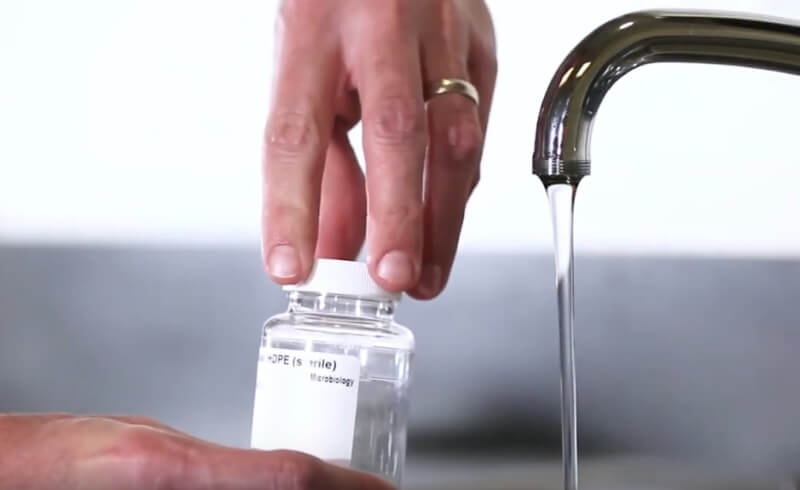
Testing Filter Water vs. Unfiltered Tap Water for Lead
But… what if you drink most of your water from a refrigerator dispenser or other point-of-use filter? The reported water test results for lead in your drinking water may not be accurate because of a water filter, while your unfiltered tap water could contain more lead.
Certain NSF-certified filters can be very effective for lead reduction. Lead water filters attached to the faucet allow the water to flow through adsorption media, capturing contaminants such as lead. Contaminants, such as lead, are also trapped in the filter and remain inside it, reducing their presence in the filtered drinking water. Search for the NSF stamp to ensure the water filter or cartridge you purchase is certified by NSF International to NSF/ANSI 53 or NSF/ANSI 58. That lead in drinking water is listed on the packaged water filter as one of the contaminants that will be reduced.
Here is an NFS Consumer Guide of water filters certified for drinking and lead reduction.
Remember that not all water filters are NSF Certified and should not be relied upon to reduce lead in water. If you have an inline refrigerator filter installed, it may or may not be certified by the National Sanitation Foundation (NSF) for lead reduction in drinking water.
Test Your Unfiltered Water Service Line First
Where they are present, lead service lines (LSL), which connect the water main to a building with indoor or household plumbing, remain the largest contributor to lead in drinking water in homes.
Filtration of tap drinking water through point-of-use (POU) water treatment devices has gained acceptance and popularity, partly due to concerns regarding lead contamination from service lines and interior plumbing materials.
Interior lead-containing plumbing materials, including brass fixtures and fittings, lead solder, flux, water meters, lead goosenecks, and galvanized steel pipes, can also release large amounts of lead into drinking water if present in a plumbing system.
Testing your unfiltered water source will give you a baseline of your water quality by determining whether lead is contaminating your drinking water.
Only qualified laboratory testing can confirm the amount of lead in drinking water. Home test kits may not accurately measure water quality, but they are quick, inexpensive, and somewhat reliable.
Sampling – How to Test for Lead in Water
There are two standard methods of collecting water samples when testing your water for lead:
- First Draw
- Fully Flushed
The main difference between these two water sample collection methods is the time the water has been sitting in the pipes before the sample is collected.
A First Draw Water Sample for Lead in the Water
Take first-draw samples from fixtures throughout the home used for human consumption. The Environmental Protection Agency strongly recommends collecting these water samples from all water taps used for drinking or cooking, prioritizing the high-risk outlets (i.e., fixtures known to or potentially contain lead and fixtures used most frequently).
Your home or building’s plumbing profile will help pinpoint high-risk fixtures and prioritize sample collection for lead testing in water.
If you collect a first draw sample, a first draw sample means that you are collecting water that has been sitting in the pipes for some period, anywhere from an 8 to 18-hour stagnation period, so the water has had time to collect contaminants possibly. Water that may be consumed at the beginning of the day or after infrequent use in your home.
A first-draw water sample is best collected before water throughout the home or building is used.
First-draw sampling can be helpful in testing for certain contaminants, such as lead or copper. However, it’s important to note that a first-draw sample may not represent the water quality throughout the system.
Thoroughly Flushed Water Sample – How to Take a Sample for Lead Comparison
If you’re collecting a sample for general testing, a thoroughly flushed sample is the way to go. A fully flushed water sample is a sample that has been collected after the tap has been run for about 5 minutes. Any stagnant water sitting in the pipes is cleared out by running the tap (or flushing the water line). The water collected after these 5 minutes will give you a better idea of the water quality, as it comes directly from the source.
This method is frequently used by those on a private well concerned about the source water quality. However, the thoroughly flushed method is also sometimes recommended for specific contaminants. For example, if you are concerned about lead in your water, flushing your pipes for 5 minutes before collecting a sample will help to clear out any lead that may have built up in your plumbing.
Ultimately, flushing your pipes before collecting a sample is an excellent way to get a more accurate picture of your water quality. Still, it would NOT be the best method to reveal if lead leaches into your water from the service pipe or fittings.
Dos and Don’ts of Sampling for Lead in Water
Lead Water Sampling – Dos:
1 – Follow the instructions provided by the laboratory that will come with your water test kit for lead. Handling water sample containers correctly is important to ensure optimum water testing results.
2 – Assign a unique sample identification number or name to each sample collected. If you are submitting numerous water samples, use a coding system to help differentiate them. Don’t forget to complete the label for each sample bottle.
3 – If you are testing water for lead in a facility or large building, collect all water samples before the facility opens and before any water is used. The water should sit in the pipes unused for at least 8 hours but not more than 18 hours before a sample is taken. This remains good advice for testing home drinking water for lead in 2024.
4 – Cold water must be collected for all samples.
5 – Learn how water flows in your facility. If there are multiple floors, it is typically recommended to sample from the bottom floor and continue up. Start sampling closest to the main and work away.
If you are testing your home water for lead contamination, take a sample from the location most used in your home for drinking water that is NOT filtered.
6 – Take a photo of the faucet or outlet sampled
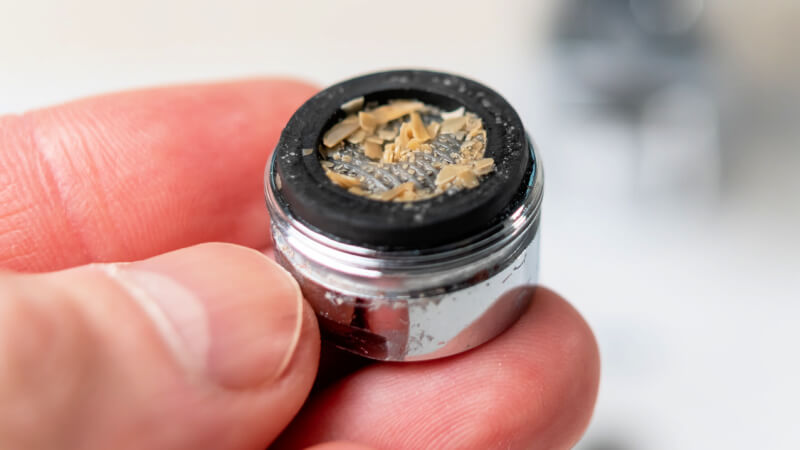
Lead Water Sampling – Don’ts
1 – Don’t remove aerators before sampling. Potential sources of lead may be missed if aerators are removed since debris could be contributing to the lead in drinking water if particles containing lead are trapped behind aerator screens
2 – Do not flush the sample site for any time immediately before the sampling period of inactivity. Flushing can be a tool to improve water quality, especially after long holidays or weekends. However, flushing before sampling may cause the lead results to show lower than the actual representative lead levels in the water.
3 – Don’t close shut-off valves to prevent their use before sample collection. Tiny bits of metal scrapings from the valves may cause the report to indicate higher-than-representative lead levels in the water.
Locations for Collecting Water Samples for Lead
Water samples for lead water testing should be drawn from potable drinking water locations before drinking any water for at least 8 hours.
Potable water locations would include hydration stations, hallway drinking fountains including coolers and bubblers, classroom faucets, classroom drinking fountains (bubblers), sinks used for teeth brushing, main kitchen tap, plumbed coffee machines, kitchen ice machines, and kitchen food preparation and rinse sinks.
When possible, it’s best not to collect water samples from bathroom hand wash sinks, kitchen hand sprayers, slop sinks, and other designated hand wash sinks such as those in kitchens.
Chain of Custody – Test Drinking Water for Lead
A critical activity within any data collection phase involving physical water samples is the handling of sample media before sampling, handling/transporting sample media to the field, handling water samples from the field at the time of collection, storage of samples (at home, field or other locations), the transportation of samples from the field site, and the analysis of the samples.
Proper documentation of these activities is essential to create a custody record, which tracks samples through sample collection, processing, and analysis. Chain of Custody records document the chain of custody for each water sample, ensuring that the sample’s integrity is maintained throughout the process. By following proper procedures for sample media handling, we can be confident that our data will be accurate and reliable.
Without a complete and accurate chain of custody record, it would be difficult to determine if mistakes had been made in sample handling, which could lead to inaccurate data. The custody record is vital in ensuring the accuracy and quality of data collected from physical samples.
Documentation Required for Lead Water Sample
Record each sample bottle’s unique identification number, date, and time.
The Chain of Custody form may include the following information:
- Type of sample taken (e.g., initial first draw)
- Date and time of collection
- Name of the sample collector
- Unique sample identification number
- Location of the sample site
- Water treatment already in place in the building or point-of-use (POU) water filter devices
- Aerator or screen on the outlet, if applicable
- Any observations that may impact the sample’s results should be recorded on a sampling field notes form—for example, leaking faucets or drinking water fountains, discolored water, low water pressure, etc.
- Photo of the outlet.
Glossary of Terms for Lead in Water?
Aerator: An aerator, also known as a “screen,” is a small metal or plastic mesh screen attached to the fixture valve of a tap or drinking water fountain. The purpose of an aerator is to improve water flow out of the tap or fountain. Aerators also collect sediment and lead particulate.
When these materials build up in the fixture valve, they can cause reduced water pressure and decreased water flow, possibly increasing the lead level in drinking water.
By attaching an aerator to the water faucet, you can improve the performance of your tap or fountain. In addition, regular cleaning of the aerator screen will help prevent the build-up of sediment and lead particulate.
Drinking Water Fountain: A drinking water fountain, also known as a water cooler or a water fountain, is a fixture that dispenses water for drinking. There are different types of drinking water fountains, including those with central chillers, bottled water fillers, and water coolers. Each type has its benefits and drawbacks.
Faucet: The word “faucet” is derived from the Old French word “faucet”, which means “tap.” A faucet is a plumbing fixture that provides hot and cold water for various consumptive uses. Faucets are usually attached to a sink or tub fixture and controlled by a handle or lever. The term “faucet” is used interchangeably with “tap.”
First-Draw Samples: These are the samples taken immediately after turning on the faucet or valve, without spilling, if possible. These samples represent the lead content of water sitting in water outlets used for drinking or cooking within the building(s).
Flush Samples: These samples are taken after the water has been running from the fixture for some pre-determined length. They can determine if lead is coming from the fixture itself or interior plumbing.
Lead-free: Per the Reduction in Lead Drinking Water Act of 2011: not containing more than 0.2 percent lead when used concerning solder and flux; and not more than a weighted average of 0.25 percent lead when used for the wetted surfaces of pipes, pipe fittings, plumbing fittings, and fixtures.
Use Lead-Free Pipes, Fittings, Fixtures, Solder, and Flux for Drinking Water.
Sediment: If you have seen a glass of water with dirt or sand at the bottom, that is sediment. Small particles commonly become suspended in water as it moves through pipes.
Over time, these particles will settle out of the water and collect at the bottom of the piping. This can happen even with clean water but is more likely to occur if the water contains minerals or other contaminants.
If lead is present in the water, it can also form sediments. Lead sediments can result in elevated water lead levels and pose a health risk. Therefore, it is crucial to ensure that your plumbing materials are lead-free and to check for sediment build-up in your pipes regularly.
Sequential Samples: Water samples were collected at the fixture, one after another, without flushing beforehand or wasting water between samples.
Water Cooler: A mechanical device affixed to drinking water supply plumbing that actively cools water for human consumption. The reservoir can consist of a small tank or a pipe coil.
JUNE 17, 2022 • STATEMENTS AND RELEASES – USA
Delivering Progress on the Biden-Harris Lead Pipe and Paint Action Plan
https://www.whitehouse.gov/briefing-room/statements-releases/2022/06/17/fact-sheet-delivering-progress-on-the-biden-harris-lead-pipe-and-paint-action-plan/
EPA Links for More Information About Lead in Water
General Information About Lead in Water
How Lead Gets Into Drinking Water
Health Effects of Being Exposed to Lead in Drinking Water
Is it Safe to Shower in Lead Contaminated Tap Water?
What Am I Able to Do?
Learn More About Water Coming Into Your Home
Steps You Can Take to Reduce Lead in Your Water
Find Out if You Have Lead Pipes in Your Home
Test Your Children for Lead Levels in Their Blood
Find Out if Lead Has Been an Issue in Your Children’s School
Drinking Water Requirements for Lead in Water
EPA Drinking Water Regulations for Lead
EPA Protection Requirements for Public Water Systems
Lead In Canadian Drinking Water
Lead in Drinking Water in British Columbia

Get a monthly update of our most popular articles directly to your inbox such as Water Well Advice including Water Testing, Well Drilling... what you need to know when buying or selling Real Estate with Water Wells and Septic Systems & other rural living topics!


